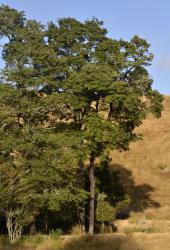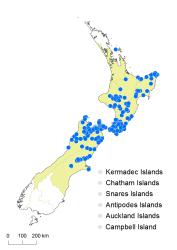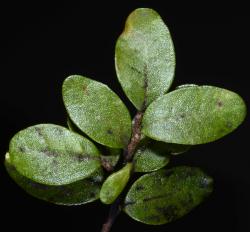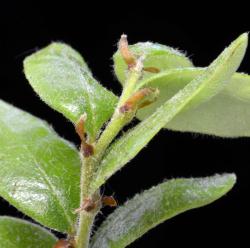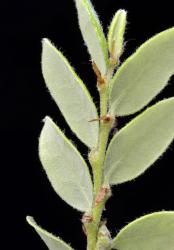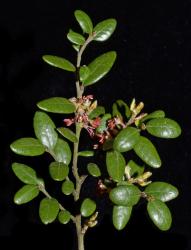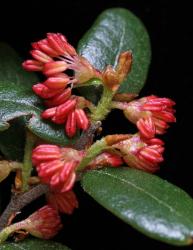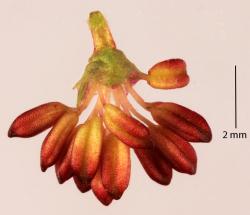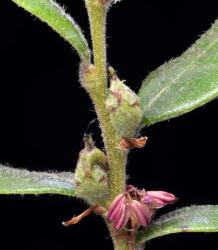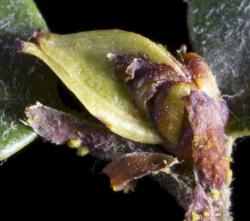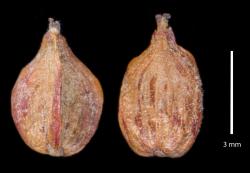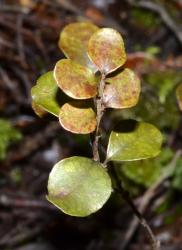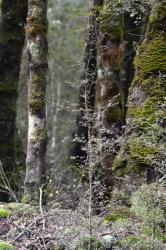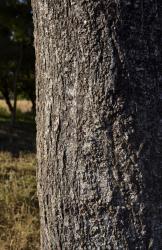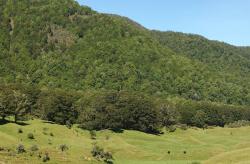- Taxon
- Gallery
- ≡ Fagus solandri Hook.f., Icon. Pl. 7, t. 639 (1844)
- ≡ Nothofagus solandri (Hook.f.) Oerst., Kongel. Danske Vidensk. Selsk. Skr., Naturvidensk. Math. Afd. 9: 355 (1871) – as solanderi
Large tree, 20–25(–30) m high; trunk straight and cylindrical, 0.6–1.0 m diameter; crown spreading. Young branchlets terete, grooved, red-brown, dark red or grey, with whitish pubescence. Stipules caducous, non-peltate, 2.5–4 mm long, narrow oblong to narrow obovate or elliptic. Leaf lamina, 8–20 × 3.5–11 mm, oblong-elliptic to elliptic to ovate, coriaceous, veins indistinct, domatia absent; adaxially glossy green, glabrescent; abaxially grey-green, thinly tomentose; margin entire, glabrous to sparsely pilose, apex obtuse often apiculate; base cuneate; petiole 0.5–2.5 mm long, pubescent to densely pilose. Staminate inflorescences, 3–5/branchlet, peduncles 0.5–3 mm long; 1 or 2 (rarely 3) flowers/dichasium, sessile to shortly pedicellate; perianth shallow campanulate, 2–2.5 mm long, glabrous to sparsely hairy, green to stramineous, often red tinged, 3–5 obtuse to acute lobes, margin glabrous. Stamens 8–16; filaments 1.5–3.5 mm long, glabrous; anthers 1.5–2.5 mm long, glabrous to sparsely hairy, dark red. Pistillate inflorescences, 1–4/ branchlet, sessile; dichasium ovoid with (1)–2(–3) sessile flowers/cupule, trimerous and dimerous, pilose, one trimerous flower often missing or atrophied in a 2- or 3-flowered dichasium. Mature cupule 3–6 mm long; valves 2 or 3 occasionally 1, short, broad to narrow triangular or ovate, coriaceous, pilose, apex acute to attenuate; lamellae 1 or 2/valve, acute or truncate. Nut (3.5–)5–7 × 3–4.5 mm long, triquetrous or lenticular, pubescent, red-brown or brown.
Bark and wood: Bark on young trees, smooth, thin and light grey to grey; bark on old trees fibrous and fissured, dark to almost black. Sapwood white to yellow-white when fresh, usually darker than that of Fuscospora cliffortioides; heartwood black-brown or light brown when fresh.
Juvenile leaves: Broadly ovate, oval or suborbicular, with obtuse apices, sometimes red or bronze; saplings often with semi-divaricating habit.
There are significant zones of hybridisation with Fuscospora cliffortioides, one occurs along the Southern Alps foothills of Canterbury, from the vicinity of the Hundalees to south of the Rakaia River to Alford Forest and Staveley. In the North Island mountain beech is likely to be introgressed with F. solandri where they come into contact around the central volcanoes and along the axial ranges. Hybrid populations, between approximately 300–600 m a.s.l., are often morphologically intermediate and difficult to determine to one or the other species. Specimens from populations on Banks Peninsula also show intermediate character-states between F. solandri and F. cliffortioides and possibly F. fusca.
Distinguished from most other species of southern beech, except for Fuscospora cliffortioides, by an entire leaf margin. Separated from F. cliffortioides by an oblong-elliptic to ovate lamina tapered equally to the base and with an obtuse apex versus an ovate to triangular-ovate lamina tapered obliquely to the base and with a subacute to acute apex. Fuscospora solandri is more densely pilose on the cupule and flower than F. cliffortioides.
North Island: North Auckland (Little Barrier Island), South Auckland (an isolated population west of Mamaku Plateau, Raukūmara Range, Urewera National Park, Kaimanawa Range, Kaweka Range, Volcanic Plateau), Gisborne, Taranaki, Wellington (Tararua, Rimutaka and Aorangi Ranges, Wairarapa).
South Island: Nelson, Marlborough, Westland (south to the upper Inangahua and Maruia Valleys), Canterbury (mid-Canterbury south to Staveley and Banks Peninsula).
Altitudinal range, sea-level–914 m a.s.l. (Raglan Range, Marlborough). Montane forest mostly below 600 m. In mixed forests with podocarp/broadleaf species and with Fuscospora truncata in the North Island and the north-west of the South Island. Dominant across slopes and gullies in the drier areas east of the axial ranges, becoming confined to ridges and glacial alluvial surfaces in the south-west of its range (Buller-Inangahua).
Flowering: Sep.–Dec. (mast seeding)



